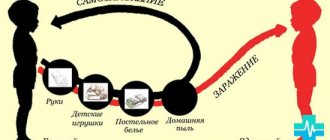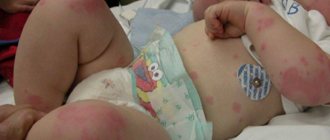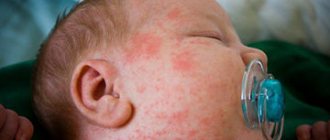A typical childhood infectious disease is measles. The distinctive signs of measles in children are so specific that diagnosis is usually not difficult.
The use of measles vaccine has significantly reduced the incidence among children. Recently, due to parents' refusal to vaccinate, the situation has become worse. The lack of vaccine also has a negative impact.
Measles usually affects children, but outbreaks of infection are often recorded in older age groups. A person who has not been vaccinated and has not had measles can become infected if they come into contact with someone who is sick. Measles can also occur in vaccinated people in case of a sharp decrease in immunity. This prevents the body from fighting the virus.
How does the infection spread?
The transmission of the virus is characterized by airborne droplets. When a patient coughs or sneezes, they release dangerous viruses into the environment. The infection enters the child's body through the respiratory system. Then it enters the blood. The virus is delivered to all organs through the bloodstream. It affects the skin, mucous membranes of the eyes and mouth, and the respiratory tract.
The source of infection is a sick person. He begins to pose a threat to others, starting from the last two days of the latent period. The ability to become infected disappears only on the fifth day after the rash appears.
At the age of 2-5 years, the disease occurs quite often and is severe. Therefore, parents should know the characteristic signs of measles in children.
Complications after measles
Health-threatening complications after measles usually develop in children under 5 years of age. Most often this is:
- otitis;
- laryngitis;
- bronchopneumonia;
- stomatitis;
- blindness;
- encephalitis;
- inflammation of the lymph nodes in the neck;
- tracheobronchitis;
- polyneuritis;
- damage to the central nervous system.
Complications after measles in children are far from uncommon, so treatment must be carried out under constant medical supervision. Ideally, a local doctor should visit a small patient every 2-3 days.
Where does the disease begin?
The most vigilant parent will not be able to determine that a disease has settled in the child’s body. The insidiousness of measles is that it does not make itself felt for 1 or 2 weeks. There is nothing special about the child's behavior. He maintains his usual activity. But the virus is already developing in his blood.
The period from the virus entering the body to the moment when the first alarm “signals” appear is called incubation. At this time, all symptoms are absent.
In the catarrhal stage, measles is manifested by decreased appetite, weakness, general discomfort, insomnia, and headaches. The child's temperature may rise (up to 38-40 degrees).
The presence of a runny nose, purulent nasal discharge and dry cough leads to an erroneous diagnosis. It can be assumed that the child has ARVI.
Specific signs of measles are a hoarse voice, red eyelids, and excessive lacrimation. Other symptoms are also present: discomfort from light, purulent conjunctivitis. Children complain of pain in the abdomen. The stool becomes liquid. In infants (up to one year), weight decreases sharply.
Treatment of measles in children
There is no specific treatment for measles. Viruses that have already entered the body cannot be killed with medicine. To alleviate the condition, symptomatic treatment is used.
What does symptomatic treatment mean?
Elimination of emerging symptoms or their weakening. Without treating the cause of the disease.
Hyperthermia - elevated temperature is relieved with antipyretic drugs. Paracetamol for children, Nurafen.
Cough - humidify the air, ventilate the room.
When bacterial complications occur, antibiotics are used.
When the first signs of measles appear, especially when the child has not been vaccinated, you should immediately consult a doctor. Do not treat the child yourself, this can lead to complications and death of the child.
Four main symptoms of measles
21 days after the onset of measles symptoms, the time for the main signs begins. Symptom number 1 is the appearance of grayish-white small rashes. Their size is no larger than the poppy's head. It is quite difficult to notice such signs, since they are localized in the oral cavity. The rash affects areas near the molars.
After five days, the symptom complex is supplemented by three other indicators:
- Bright spots merging one with another up to ten millimeters in size. They protrude above the surface of the skin. The sequence of their appearance is as follows: behind the auricle, forehead, face, neck, body, limbs.
- Pink spots begin to actively increase in size. If you look at a photo of the patient’s skin, it’s as if the rash covers the body like a continuous sheet.
- After 3 days, the crisis begins again and the temperature rises to 40.5 degrees.
The above symptoms of measles in children are standard. They are observed during any course of the disease. The spread of the rash lasts 4-7 days. Then the color of the spots changes from red to brown. The skin in these places begins to peel off (as in the photo). After two weeks, the child’s skin becomes clean. The disappearance of the rash in children occurs in the same order as its appearance: on the 1st day of recovery, the face clears, and last of all, the rash disappears from the legs and arms.
Vaccinations
The most reliable and effective method of preventing the disease is the measles vaccination, which is an artificial, weakened infection of a small organism with a virus, resulting in the development of protective immunity. What parents should know about this vaccination:
- after vaccination, from 6 to 20 days the temperature may rise, conjunctivitis may appear, small rashes may form on the body - all this is harmless and goes away within 2-3 days;
- The first vaccination against measles for children is carried out at 1 year, the second - at 6 years;
- in this case, doctors use mono-vaccines or tri-vaccines (rubella, measles, mumps);
- vaccination guarantees a lasting effect of protection against measles for 15 years;
- Contraindications to measles vaccination include diseases such as: acute infections, blood pathologies, heart damage, rheumatism, acute nephritis.
Despite the severity of the disease, the prognosis for childhood measles is favorable. Death occurs extremely rarely - only when complications develop due to late or improper treatment.
Medical diagnostic methods and treatment
The doctor takes into account not only those symptoms that are visible to the naked eye. For an accurate diagnosis, blood and urine tests are performed. Sometimes they resort to serological testing. This procedure helps detect antibodies to the measles virus. A chest x-ray is also taken. If a complication occurs, the doctor may prescribe electroencephalography.
Modern medicine does not have specific treatments for measles. If anti-measles immunoglobulin is administered during the incubation period, this does not guarantee a 100% effect. The methods used to treat measles are aimed at reducing and eliminating the symptoms of the disease.
The child is prescribed bed rest, given antipyretics and plenty of fluids. The list of medications for the treatment of measles includes medications that relieve sore throat and expectorants. In order to support the body, vitamins are prescribed.
A runny nose is treated with vasoconstrictors. Eyes are washed with warm boiled water. For these purposes, sodium bicarbonate is used. Retinol or sodium sulfacyl is instilled into the nasal passages. For children under 1 year of age, clean their nose with a cotton swab dipped in heated Vaseline oil. Patients are prescribed a diet consisting of fruit juices, teas, compotes, jelly and fruit drinks.
Those children whose disease proceeds without complications can be treated at home. If atypical conditions develop or the baby is under 1 year old, he is placed in a hospital.
Measles is usually accompanied by complications if children are over five years old. Diseases of the ENT organs and disturbances in the functioning of the respiratory system may occur. The infection can also provoke more severe conditions: encephalitis, loss of vision, polyneuritis.
To exclude the possibility of developing dangerous diseases, it is necessary to seek help from a doctor. He monitors the course of the disease by visiting the patient every 1-3 days.
Diagnosis of the disease
The doctor makes a diagnosis based on the clinical manifestations (described above) and the complaints of the small patient. Additionally, the following may be assigned:
- general blood and urine tests;
- serological test (detection of antibodies to the measles virus in the child’s blood serum);
- isolation of the virus from the blood;
- chest x-ray (done only in exceptional cases);
- electroencephalography (performed only in the presence of complications on the nervous system).
In most cases, diagnosis does not cause difficulties for doctors.
Is it possible to prevent the disease?
Method No. 1 for preventing measles is vaccination. The purpose of the vaccine is to introduce a weakened virus into the body. This leads to the formation of protective immunity in children. The first vaccination is carried out at 1 year of age, the subsequent one at 6 years of age. The vaccine provides protection against measles for 15 years.
Cases of the disease occurring in children vaccinated with a high-quality vaccine are extremely rare. After administration of the drug, mild symptoms of the disease may be observed. This applies to fever, minor rashes, and general malaise. Such side effects will disappear after a couple of days.
Measles is quite severe in children, but the medical prognosis is favorable. Difficulties can only arise if you do not consult a doctor in a timely manner or with incompetent treatment.
To maintain your child’s health, you should not make diagnoses or prescribe treatment yourself. A thoughtless refusal to vaccinate leaves a child's body defenseless against a dangerous infection.
Disease prevention
Childhood measles can be prevented if you follow the advice of doctors and take all necessary preventive measures against this disease:
- vaccination;
- isolation of healthy children from sick ones;
- daily preventive examinations, thermometry of children in the source of infection;
- When measles is detected in a kindergarten or school, children under 3 years of age are given anti-measles immunoglobulin within the first five days after direct contact with a sick child.
Children who are over three years old, have not yet been vaccinated, have not previously had measles, and have no contraindications are subject to mandatory vaccination. Children who have been in contact with a sick person, who have not had measles and have not been vaccinated, are subject to quarantine. Sometimes prevention and treatment are not as effective as we would like, and all sorts of complications develop.
First signs
At the beginning, measles occurs with virtually no symptoms. The initial stage can last for a week and the parent will not even suspect that the child is sick. The first signs of measles are the same as those of acute respiratory disease:
- increased body temperature;
- cough;
- runny nose.
The danger lies in the absence of obvious signs of the disease, so the child can continue to visit kindergarten and other public places, infecting others.
Causes
Measles season is considered to be from October to April. At this time, crowds of people indoors are dangerous, as the virus is transmitted by airborne droplets.
The causative agent of measles is an RNA virus from the genus Morbillivirus. It consists of a nucleocapsid, which includes a ribonucleic acid helix, as well as outer shell proteins. The antigenic structure of the virus is similar to parainfluenza and mumps viruses.
The measles virus is poorly resistant to the external environment, so outside the human body it quickly dies. For example, at room temperature the measles virus can survive for 1-2 days, and at low temperatures it can remain active for up to several weeks. However, there are cases where the virus has spread through the ventilation system with air flow.
The virus is released from humans through droplets of saliva or when the sick person sneezes or coughs. The entry point for infection is the mucous membrane of the upper respiratory tract. People who have had measles develop immunity for life, but those who have not had measles are at constant risk.
Prevention
Prevention consists of administering a vaccine. The vaccination is given between the ages of 1 and 6 years. Immunity after vaccination remains for a long time, but it is not lifelong. In adulthood, revaccination is carried out.
If a child has been in contact with a sick person, he needs urgent vaccination. The administration of immunoglobulin the first day after contact will help, if not prevent infection, then make the course of the disease easier.
Measles is a dangerous disease that is transmitted by airborne droplets. Its danger lies in the absence of pronounced symptoms at the onset of the disease. To protect your child from infection, you should be vaccinated in a timely manner.
Complications that may arise due to the disease
You only get measles once in your life.
However, this disease does not always go away without a trace. With the onset of the disease, the body is deprived of the remnants of its immunity, which is restored only after a few months if every effort is made.
Complications can affect the organs:
- respiratory system;
- central and peripheral nervous system;
- gastrointestinal tract.
There are primary and secondary complications. Primary ones are formed under the influence of a virus, secondary ones - from attachment to an infection virus.
Primary complications
Primary are those diseases that develop along with the onset of measles. These are bronchitis, laryngitis, pneumonia, pericarditis, meningitis. In rare cases, acute encephalitis and subacute panencephalitis—slow damage to the central nervous system—occur. This disease occurs in children 5-7 years old who have had measles; it is fatal.
Secondary complications
These complications arise as a result of bacterial infection of internal organs. They can lead to complete organ dysfunction such as blindness, deafness, anemia, and even death if vital organs fail.
Symptoms
A characteristic sign of the development of the disease is the appearance of spots at the base of the molars. This indicates that the virus has begun to destroy the mucous membranes of the oral cavity. Such spots are white with a red border. They distinguish measles from other diseases with similar symptoms.
Other symptoms of the disease include the following:
- abdominal pain;
- stool disorder;
- inflammation of the mucous membranes of the eyes.
The child also develops a rash on the face, which eventually spreads throughout the body. After a week, the rashes acquire a paler shade, and light pigment spots form.










